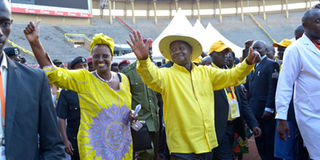When internal wrangles shook NRM party

President Museveni and First Lady Janet Museveni wave to party delegates at the end of the NRM conference at Namboole stadium on December 15. This year, the party has had to deal with internal leadership challenges that threatened to divide the party. PHOTO BY PPU
What you need to know:
Review. As 2014 comes to a close, Daily Monitor lays bare the key moments for the ruling party.
Kampala. Let us start from how it ended. A forlorn, bespectacled Amama Mbabazi, seated near his childhood friend Dr Ruhakana Rugunda, quietly following events at the December 15 NRM delegates conference.
Dressed in a deep black striped suit and white shirt, Mr Mbabazi was the only high-ranking party member, who wasn’t draped in party colours save for the yellow tie.
At the end of the day, the NRM national conference had passed a resolution empowering the chairperson to appoint the party’s secretary general and subsequently and retrospectively, cut short the term of the office bearer. It was, in effect, a coup on Mr Mbabazi, hitherto the most powerful person in the ruling party.
The national conference was only an embalmer’s table. The idea had been fought in the party’s Central Executive Committee meetings, killed in the National Executive Committee meeting and it was only being presented for rubberstamping in public.
A total of 10,000 delegates, picked from across the country and verified using a fine tooth comb that only those who were ‘politically right’ got selected, had been transported, fed, entertained, dressed and driven to Namboole to rubberstamp the chairman’s quest for more power and control over the party.
Thus, the political year ended with a result that the party badly needed for more than 12 months— kicking Mr Mbabazi out of the party secretary general post, and replacing him with an appointed one. Ms Kasule Lumumba, the party Chief Whip in Parliament, has since been nominated for that post.
‘Tipping point’
Mr Hippo Twebaze, a political researcher, says 2014 has shown how NRM is on the verge of internal collapse if disagreements are not handled in a more democratic manner.
He argues that the excitement and lack of restraint among young party members through the year has not helped the party but has only contributed to internal disintegration and a disappearance of the party ideology.
However, minister for Presidency Frank Tumwebaze says the party’s biggest challenge has never been lack of a superior ideology nor is it lack of popular mass support.
“Our biggest challenge has been organisational and, therefore, operational. We have grassroot structures in all 57,000 villages, with 30 leaders in each village,” Mr Tumwebaze said.
He added: “Maintaining active linkages with them has been the biggest challenge because of a non-functioning national secretariat. Fortunately, the constitutional reforms just passed by our party decision making organs are all meant to fix all these organisational challenges.”
In 2015, he said, the party will be focusing on institutional building in readiness for 2016 general elections and beyond.
In the party, 2014 began with a debate on whether Mr Mbabazi should relinquish the position of secretary general. When he refused, a consistent push to undermine his authority in the party started.
This culminated in the famous Kyankwanzi resolution, his being dropped from the prime minister position and his eventual overthrow from the secretary general post. It has taken a full year.
The year also saw the coming of the sole candidate proposal—the move to have President Museveni as an unopposed candidate for the NRM presidential flag bearer in the 2016 elections.
Buliisa MP Stephen Birahwa says the proposal exposed the political immaturity of the youth.
“It’s them who fronted and pushed for the sole candidate project in essence saying they are not ready to lead. My hope is that by 2021, they will be ready to lead,” Mr Birahwa says.
Lwemiyaga County MP Theodore Ssekikubo, who was expelled from the party in 2013, says this has been the period the NRM has witnessed most upheavals and plans he had made such as reducing corruption have not worked.
Mr Ssekikubo argues that through the year, President Museveni, the party leader, has only seen the growth of opposition from within the party, from rebel MPs to now the secretary general.
“The mantra of let’s do away with them has eaten up the party but deep inside him, he knows he is at a loss. Elections are fast approaching and he needs time to mend fences,” he says.
In Parliament, some of the highlights in the party have been the return of the VAT Amendment Bill 2014 and the Public-Private Partnership Bill over disagreements on contents and what the House had passed. Buliisa county representative Birahwa Mukitale acknowledges that the party has ended the year trying to solve problems that we began the year with.
“What confirms the strength of the party is the way you solve internal problems,” he said. “My advice is that we get better ways of solving the problems than this last minute approach of dealing with individuals.”
However, he argues the party needs to patch the loopholes in the procurement processes because currently as a party in government, NRM is superintending a system where government officers and public servants double as commission agents.
This failure to curb the escalating corruption is also noted by Bunyole East MP Emmanuel Dombo. “We have not performed well on that front. We have seen the coming up of the Katosi road scandal, the standard gauge railway scandal. All that comes back to the party because it is in government,” Mr Dombo says.
“We should spend 2015 on working hard to fulfil the promises we made to the people through our manifesto and also focus more on fighting corruption,” he adds.



